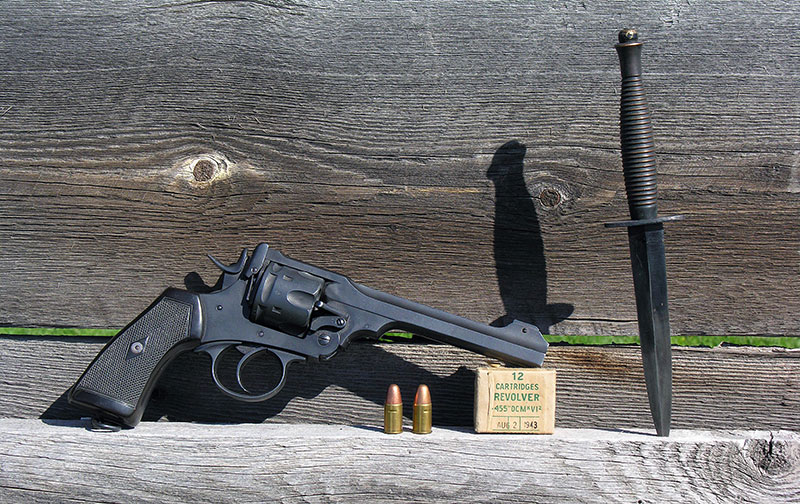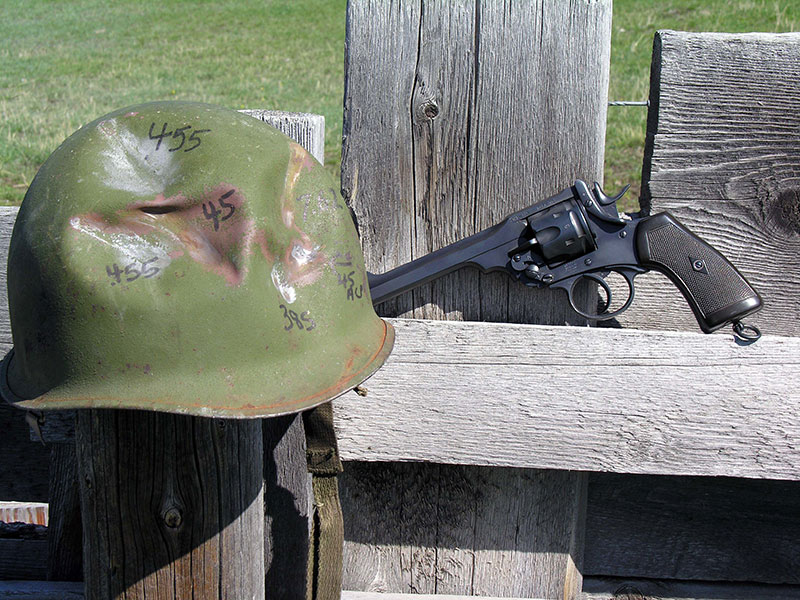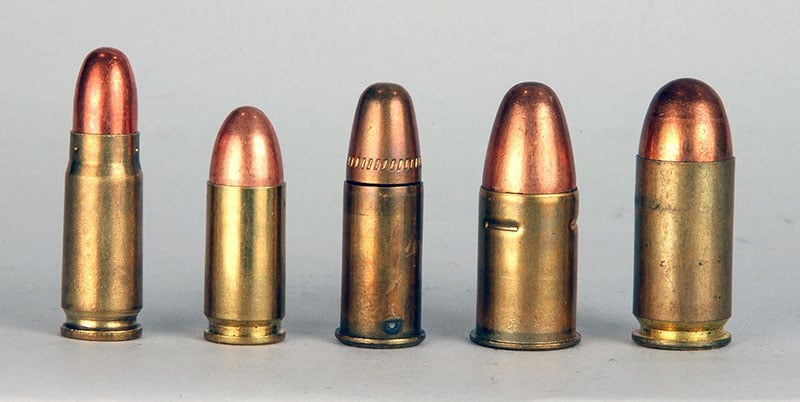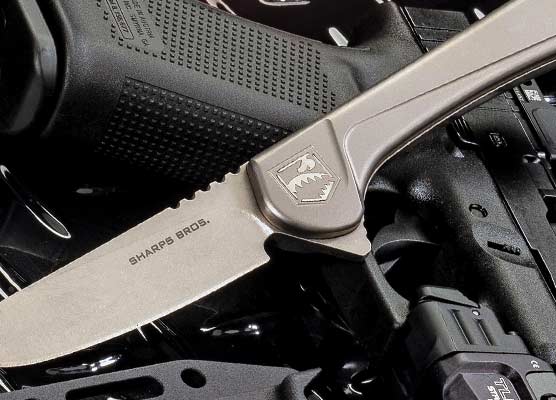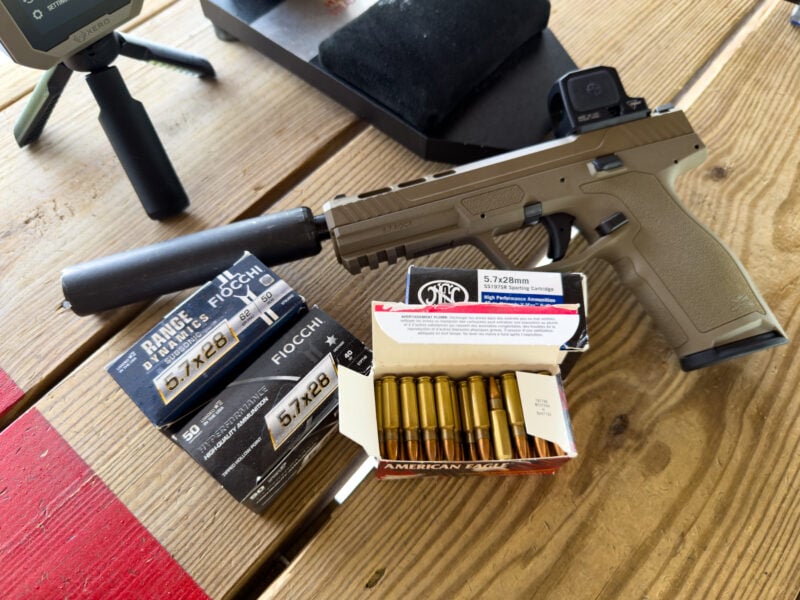Handguns Of WWII, Part 10
The Webley MK VI .455
Part 10 Of A 13-Part Series
Some folks hold the Webley Mk VI .455 revolver in near reverence. I’m not one of them. To me it’s big, clunky, ugly, underpowered and worst of all I don’t think it is a very accurate handgun. Many attribute the weakness of its .455 cartridge as being necessitated by its top break design. That’s not actually the case because boat-loads of them were altered to fire more powerful .45 ACPs with no problems.
The Webley line of revolvers began as early as 1887 with the Mk I and its black powder ammunition. As ammunition technology and metallurgy progressed the design likewise evolved through various “marks” until the Mk VI arrived in 1915 during the “Great War.” Where the early versions had 4″ barrel lengths the short-lived Mk V and then the much longer lasting Mk VI had 6″ lengths.
That barrel is odd in form: machined flat on both sides, left round on the bottom, but with an integral rib machined atop it. The good thing about it is there’s a stud near the muzzle into which various heights of sighte blade can be attached by a single screw. Therefore, zeroing for elevation is simple if you have access to the various sight blades. There is no provision for zeroing a Mk VI for windage. As with many types of top break revolvers, the rear sight is a simple notch cut in the barrel release.
Using It
Operation of the Mk VI is likewise simple. Press the release lever on the left side of the frame’s rear and the barrel/cylinder assembly can be manually pushed downwards. As that happens the star-type extractor cams upwards ejecting all cartridges whether fired or not. As the barrel reaches its downward limit the extractor back falls into place so the chambers can be loaded once again. After they are the barrel is raised until the release lever engages it once again. (Does that release lever remind anyone else of a flush lever on a toilet?)
Then the revolver is ready for firing. Trigger manipulation can be either by single or double action mode. When the trigger is not pressed the cylinder has quite a bit of wobble in it. That is normal. When pressed the rotating hand presses on the cylinder ratchet, pushing it to the right and taking out most of the wobble. Hopefully the design is built so this right push centers the chambers with the barrel’s forcing cone and doesn’t make them off center when the round is fired.
Here’s one conundrum. In 1915 the British complained to Smith & Wesson that their Hand Ejector First Model was prone to malfunction in the mud and dirt of trench warfare. Supposedly the reason was the S&W’s ejector rod had a shroud enclosing it except on one side and its third lock mounted on the crane also fouled. Those may be, even probably were, viable problems. However, the Brits’ own Mk VI design has various parts of its extraction system setting outside the frame where any sort of crud can get into them.
Here’s a second conundrum. Why did the British use such a puny cartridge for this massive handgun? In the book Military Small Arms Of The 20th Century, by Ian V. Hogg and John S. Weeks, there are two .455 Webley military loads listed. The 265 gr. lead bullet version termed the Mk II is rated with a muzzle velocity of 580 fps. The Mk VI load with 265 gr. full-metal jacketed (FMJ) bullet is rated at 620 fps. For the purpose of comparison, the same source rates the U.S. military .45 ACP load as having a 230 grain FMJ bullet at 860 fps. (We’ll return to this comparison again shortly.)
Conversions
Many thousands of these Mk VI Webley revolvers have been converted to .45 ACP. In fact at modern gun shows it is much easier to find one of those converted Mk VIs than those still in the original chambering. The reason was.45 ACP military surplus ammunition was much more common in the ‘50s and ‘60s when Britain sold off their obsolete military handguns, mostly in the U.S. marketplace. The primary, maybe only, source of .455 Webley ammunition was from Canada so supplies were not overly common.
That has changed nowadays. Surplus .45 ACP ammunition is all but unobtainable while new factory loads for .455 Webley can be had either from Fiocchi (imported from Italy) or made domestically by Hornady. Handloaders have it even easier. Until just a few years ago handloaders had to alter .45 Colt cases by thinning the rims and cutting the cases down to .76 inch. Now they can just buy ready to load Hornady brass.
When I started to handload .455 Webley for my Mk VI I knew a variety of .45 Colt bullets would give more or less suitable results. No problem there, but brother was I surprised to find that RCBS catalogs a bullet mould specifically for .455 Webley shooters. In profile it duplicates the military 265 gr. FMJ bullet. The single cavity mould drops a hollowbase bullet weighing about 270 grains of a 1-20 tin to lead alloy. Those bullets look great but it’s actually not necessary to cast all your .455 bullets slowly in a single cavity mould.
I’ve found the .454″ diameter swaged lead 255 gr., .45 Colt bullets of roundnose/flatpoint form also shoot fine. Loading data for .455 Webley disappeared from most reloading manuals back in the 1960s but one of my old ones listed a powder charge of 3.0 grains of Bullseye for .455s. I use that with the 265 gr. bullets and 3.5 grs. with the 255 gr. Hornady bullets. The resulting velocities are 620 and 690 fps respectively. Hornady’s 265 gr. lead bullet factory load gave an exact 600 fps. All speeds are from the 6″ barrel of my Mk VI.
Using .45 ACP
One day I hung a surplus U.S. steel army helmet on a post. From 20 feet I hit it with a 262 gr. bullet (Fiocchi factory load) from the .455 Webley. It made a small crease and ricocheted upwards. The helmet only wobbled. Hit with a 230 gr. FMJ bullet from my Colt Model 1917 .45 revolver, the side of the helmet caved in, it jumped off the post and rolled about 20 feet across the ground. Big Difference!
Adopted in 1915, the Mark VI served as standard issue to British forces until about 1928 when it was superseded by the .38 caliber No. 2 Enfield. However, so many hundreds of thousands of Mark VI .455s were on hand when Britain declared war on Germany in 1939 that they served for the duration. A Webley Mk VI was necessary to fill out my World War II handgun collection but it is far from my favorite pick.
Click here to links to all the 13-part on-line series of Handguns Of World War 2 articles.

